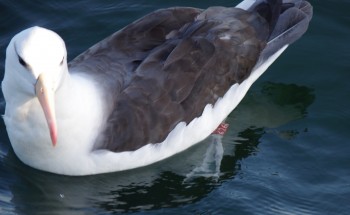
Black-browed Albatross, photograph by Kolette Grobler
Letizia Campioni (MARE—Marine and Environmental Sciences Centre, ISPA—Instituto Universitário, Lisbon, Portugal) and colleagues have published in the journal Behavioral Ecology on isotopic signatures of Black-browed Albatrosses Thalassarche melanophris and Cory’s Shearwaters Calonectris borealis.
The paper’s abstract follows:
In long-lived species with slow maturation, prebreeders often represent a large percentage of the individuals alive at any moment, but their ecology is still understudied. Recent studies have found prebreeding seabirds to differ in their isotopic (and trophic) niche from adult breeders attending the same nesting colonies. These differences have been hypothesized to be linked to the less-developed foraging performance of younger and less-experienced immatures or perhaps to their inferior competitive abilities. Such differences from adults would wane as individuals mature (“the progressive ontogenetic shift hypothesis”) and could underpin the prolonged breeding deferral until adulthood displayed by those species. This study documents a marked difference in the nitrogen and carbon isotopic ratios measured in the whole blood of immatures and breeders in 2 pelagic seabird species (Cory’s shearwaters, Calonectris borealis, and black-browed albatrosses, Thalassarche melanophris) nesting in contrasting environments. However, blood isotopic values did not present a relationship with prebreeder age, suggesting no gradual ontogenetic shift from an immature toward an adult isotopic niche. Furthermore, isotopic signatures of sabbatical adults could not be separated from those of immatures attending the same colonies, but were clearly segregated from adult breeders. These results suggest that isotopic differentiation between immatures and breeders is mainly linked to a factor unrelated to previous experience and hence probably unrelated to a hypothetical gradual improvement of foraging competence or competitive abilities. Any ecological differentiation between breeders and nonbreeders is more likely related to the severity of the central-place foraging constraints and to the energetic requirements of reproduction (“the reproductive constraint hypothesis”).”

Cory's Shearwater, photograph by Paulo Catry
With thanks to Paulo Catry.
Reference:
Campioni, L., Granadeiro, J.P. & Catry, P. 2015. Niche segregation between immature and adult seabirds: does progressive maturation play a role? Behavioral Ecology doi:10.1093/beheco/arv167.
John Cooper, ACAP Information Officer, 31 January 2016

 English
English  Français
Français  Español
Español